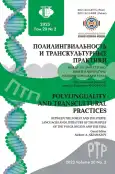Punctuation in Chuvash Media Language
- Autores: Gavrilov A.D.1
-
Afiliações:
- I. Ulyanov Chuvash State University
- Edição: Volume 20, Nº 2 (2023): BETWEEN THE FOREST AND THE STEPPE: LANGUAGES AND LITERATURE OF THE PEOPLES OF THE VOLGA REGION AND THE URAL
- Páginas: 227-239
- Seção: Language Processes
- URL: https://journal-vniispk.ru/2618-897X/article/view/326694
- DOI: https://doi.org/10.22363/2618-897X-2023-20-2-227-239
- EDN: https://elibrary.ru/JAPLBL
- ID: 326694
Citar
Texto integral
Resumo
This article raises the question of the need of studying the modern functioning of Chuvash punctuation on the material of the media language. The topic is relevant due to the fact that in the conditions of developing screen culture, journalists influence the mass consciousness intensively, their speech activity makes an impact on the linguistic tastes of society and reflects the main trends in the actual practice of writing. This is clearly seen in the example of such a stylistically and pragmatically significant unit of media speech as an online analytical newspaper headline. Pursuing the intention of persuasion, journalists use expressive punctuation resources in their headline-making, which allows them to enhance the expressiveness of their utterance and encourage Internet users to read the text. The purpose of the work is to identify some common punctuation strategies of network analytical newspaper headlines in Chuvash language. The research material was a card file of analytical materials of the headlines of the online version of The Khypar newspaper for 2017-2021 collected by the author. Relying on an integrated methodology based on the ideas of communicative-pragmatic and psycholinguistic approaches based on the intentional method, the author identified productive punctuation models of the studied titles, revealing the expressive speech-acting potential of Chuvash punctuation. The article presents and characterizes popular punctuation practices of journalists - cases of using a question mark, an exclamation mark, an ellipsis and quotation marks in the header construction. These punctuation tools allow the writer to express an evaluative attitude to the problem being discussed, convey certain emotions, highlight a significant part of the phrase, place semantic accents. The author comes to the conclusion that the study of the functioning of punctuation marks in media texts allows us to shift the focus from the study of punctuation norms to the subject of speech, to his punctuation activity due to specific intentions and communicative situations.
Palavras-chave
Sobre autores
Artem Gavrilov
I. Ulyanov Chuvash State University
Autor responsável pela correspondência
Email: artmaster28@rambler.ru
ORCID ID: 0000-0001-6031-2725
Candidate of Philological Sciences, Assistant of the Department of Journalism
15, Moscow Prospect, Cheboksary, 428015, Russian FederationBibliografia
- Dolgova, A.P., Kuznetsov, A.V. 2020. “The development of the Chuvash linguistics at the beginning of the XXist century: achievements, problems and pressing tasks”. Russian Turcology 1–2 (26–27): 88–94. Print (In Russ.).
- Kon’kov, V.I. 2016. “Media speech: the content of the concept and principles of analysis”. The World of Russian Word Journal 3: 58–63. Print. (In Russ.).
- Veshchikova, I.A. 2021. “Journalistic Style in the Modern Language Situation”. Russian Speech 2: 7–19. Print. (In Russ.).
- Gavrilov, A.D., Ivanova, A.M. 2020. “Distinctive features of the title of the online edition”. In Ashmarin Readings: collection of articles of the XII International Scientific and Practical Conference, Cheboksary, November 20, 2020. Cheboksary: Chuvash state university publ. Pp. 224–226. Print. (In Russ.).
- Gavrilov, A.D. 2021. “A Comparative Study of Punctuation in a Web Newspaper Headline: Toward a Problem Statement”. Yakovlev Chuvash State Pedagogical University Bulletin 3 (112): 3–8. Print. (In Russ.).
- Gizatullina, A.K. 2016. “Evaluation as a Form of Expressiveness: Emotionally Expressive Sentences in Tatar and French”. Philology. Theory & Practice 91 (63): 73–75. Print. (In Russ.).
- Klushina, N.I. 2018. Mediastylistics. Moscow: FLINTA publ. Print. (In Russ.).
- Budnichenko, L.A. 2003. Expressive punctuation in a journalistic text (based on the language of newspapers). Saint Petersburg State University publ. Print. (In Russ.).
- Klushina, N.I. 2022. “Intentionality of the Author’s Consciousness and Effects in Communication ”. Proceedings of the V.V. Vinogradov Russian Language Institute 1: 114– 121. Print. (In Russ.).
- Gorskii, S.P. 1959. Essays on the history of the Chuvash literary language of the pre-October period. Edited by M.Ya. Sirotkin. Cheboksary: Chuvashskoe gosudarstvennoe izdatel’stvo publ. Print. (In Russ.).
- Seagal, K.Ya. 2022. “ The origins of the psycholinguistic approach to punctuation”. Bulletin of Udmurt University. Series History and Philology 3: 529–536. Print. (In Russ.). DOI: https:// doi. org/10.35634/2412-9534-2022-32-3-529-536
- Andreev, I.A. 1972. “Chuvash writing and questions of punctuation”. In 100 years of the new Chuvash writing”: Collection of Articles. Cheboksary. Pp. 132–144. Print. (In Russ.).
- Ivanov, A.I. 1956. “Some issues of Chuvash spelling and punctuation”. Uchenye zapiski ChNII 19: 86–116. Print. (In Russ.).
- Chernov, M.F. 1963. Obosoblennye chleny predlozheniya v sovremennom chuvashskom yazyke. Cheboksary: Chuvashgosizdat publ. Print. (In Russ.).
- Andreev, I.A. 1990. Chӑvash punktuatsiiӗ: irtni, khal’khi, pulassi [Chuvash punctuation: past, present, future]. Cheboksary: Chuvash. kn. izd-vo publ. (In Chuv.)
- Andreev, I.A. 2004. Chӑvash punktuatsiiӗ: tӳrletse ҫӗnetnӗ kӑlarӑm [Chuvash punctuation: an updated edition]. Cheboksary: Chuvash. kn. izd-vo publ. Print. (In Chuv.)
- Chӑvash orfografiiӗpe punktuatsiiӗ (tӗrӗs ҫyrmalli pravilӑsem) [Chuvash orthography and punctuation (spelling rules)]. 1992. Cheboksary: Chuvash. kn. izd-vo publ. Print. (In Chuv.)
- Seagal, K.Ya. 2022. “Development of Punctuation theory in First Quarter of 21st Century: Main Trends”. Nauchnyi dialog 2: 94–121. Print. (In Russ.).
Arquivos suplementares









